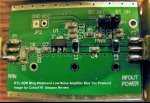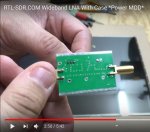I've been eyeballing the RTL-SDR wideband amplifier at Amazon (pictured below) << HERE >>. I've been wondering, does anyone here use one? If so, what are your real world results. Does it appreciably elevate the noise floor? Since I live in a rural setting, I'm thinking this may be "just the ticket", but figured it may be wise to inquire with you experts & users here first.











